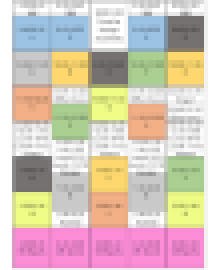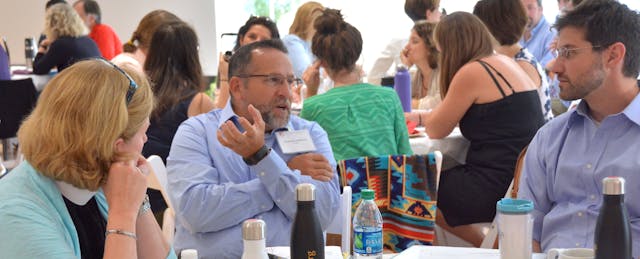It is 8 p.m. and Sam is sitting down for the first time in hours after a long day at school, which was followed by play practice; she is Liesel in the upcoming performance of “The Sound of Music.” After leaving school at 5 p.m., she had a two-hour soccer practice, a brief dinner with her family and a shower.
Finally settling in at her desk, she checks Schoology, her school’s learning management system, to see what homework she has for the six classes she will attend tomorrow. Because Sam has so many classes each day, she has a heavy homework load. Despite her knowledge of existing research about the cost transaction when switching between her academic assignments and an incoming text or Instagram message, she cannot resist social media breaks, which provide dopamine boosts. After all, she is a high school freshman.
Until recently, this late-night homework stress was a common experience for many of the high school students at St. Andrew’s Episcopal School in Potomac, Md. Since 2011, St. Andrew's has been home to the Center for Transformative Teaching and Learning (CTTL), a research center that trains public, charter and private school teachers in mind, brain and education science. The CTTL ensures that 100 percent of the faculty and administration serving students in preK-12th grade at St. Andrew’s are trained in educational neuroscience.

Ironically, even with this innovative research center, our school was operating on an outdated daily schedule. Each class met four times per week for three 40-minute periods and one 80-minute period. A typical student schedule included six classes per day, all of which assigned daily homework. We knew we could make some changes to the schedule that would better support students.
In fall 2018, after 18 months of planning, we rolled out a new schedule, which was designed with a few goals in mind:
- Lengthening all class periods to promote creative teaching and deeper learning
- Decreasing the number of class periods per day, therefore reducing homework, cognitive overload and cognitive transitions, to promote focus and moderate the rushed tempo of school life.
- Increasing time for students to meet with teachers and their peers during the school day for academic enrichment and healthy socialization.
- Minimizing conflicts between class time and other school activities, including assemblies, field trips and athletics.
- Elevating time for research-informed professional development and student passion and curiosity pursuit.
Bringing this to launch was not easy. In fact, a decade earlier, our school’s first effort to develop a new daily schedule failed. At the time, a dedicated team of teachers and administrators thought they had come up with the next frontier of school scheduling. The goal back then was to improve the school’s use of time for curricular and co-curricular programming, including arts and athletics. Unfortunately, when the time came to implement this new daily schedule, we couldn’t commit. It never launched.
What was different this time around? Our design was rooted in research.
Over the past seven years, as our implementation of educational neuroscience scaled, many of our teaching, learning and measurement practices changed. Teachers started to open and close their class periods with strategies that leveraged what we had learned about how providing students with novel experiences could boost engagement and memory retention. We explored ways to enhance the quality of homework, which included giving teachers the autonomy to not assign it. As we better understood the link between memory and cognition, and the inner workings of the brain’s architecture, we implemented new ways to care for the social-emotional development of our students. And sleep was acknowledged as vital to the health and well-being of our students—it was even starting to be considered a pedagogical strategy.
Since the CTTL launched, we have collectively evolved our understanding of research in the fields of neuro and cognitive science, behavior psychology and educational theory, and we have come to recognize the gaps between what the research suggests and daily life at our school.
Though we had changed many of our pedagogical practices, our schedule was still outdated. We wondered whether we could leverage research in educational neuroscience to transform it.
In 2017, the CTTL’s student research fellows began collecting qualitative and quantitative data by surveying the ultimate end users of our daily schedule, the students. Next, we took a design thinking approach to engage faculty and parents in the conversation and began logistical planning.
Two of the most intriguing pieces of data collected during student surveys related to class period length and homework. When we asked students about an optimal length of class, they came back with 60 to 65 minutes. When students were asked about a realistic amount of homework time that should be expected of them, we expected to receive most answers declaring “none,” but instead, students saw the value of about 90-minutes of quality homework that was assigned for one of three reasons: retrieval practice, to connect or extend prior learning or to be prepared for the next class period.
When we rolled out the new schedule at the start of the 2018-2019 school year, we recognized that even though we had done theoretical research, making actual changes in our school community would be a process, so we planned to iterate the schedule over the next three years based on feedback from the school community. Launching something imperfect when you already have something that is comfortable can be challenging, but it gave us an opportunity to model what we were already messaging to our students about “failing forward.”
Any change in a school’s daily schedule impacts the entire school community including students, teachers and families. For our teachers, it was an especially emotional transition. I had been at St. Andrew’s for 21 years, and like many of my veteran colleagues, I was quite comfortable with the schedule. Changes like longer, but fewer class periods and less homework required revising curriculum.
That’s one of the reasons why giving ourselves 18 months to transition felt important. As a research-informed school and faculty, we also recognized the importance of testing our ideas. One of the most enjoyable parts of our journey was when we piloted the new schedule for a week in February 2018, seven months before our permanent launch date. While this pilot highlighted some of the schedule’s flaws, it also assured those who were not yet on board that this was a good move. In fact, a few colleagues even suggested that we finish the year with the new schedule.
So, what were the big changes we made? In our new daily schedule, all periods are 65-minutes long and classes now meet three times per week. These changes were inspired by research on scheduling and types of effective teaching that might be easier to implement within longer periods. Classes also rotate the time of the day that they meet, which reduces the homework load, and given what we now know about sleep’s role in memory, school never begins before 8:30 A.M.
On designated Wednesdays, classes begin at 9:20am following a curiosity, passion pursuit and well-being hour for students. During that time, teachers participate in professional development programming that so far this year included working with experts, such as Dr. Robert Dillon to envision how we use space at school and Efrat Furst to help us look at memory.

After recently passing the halfway point of the 2018-2019 school year, we’ve lived our new daily schedule for just about six months. The qualitative and quantitative data we’re collecting to make our first round of adjustments for next year has revealed some early successes.

Most students say the homework load is more manageable and some say they’re going to bed earlier. Students are taking advantage of the curiosity, passions pursuit and well-being hour in a number of ways. Some are building robots, learning to code, getting support from peer tutors or doing homework that they otherwise would have stayed up later to complete—some are using the time to catch up on extra sleep. Teachers have reported that longer class periods are elevating the use of multiple modality instruction and allow now students time to go deeper into discussions and projects, or even begin homework during class time.
Launching something as ambitious as a new daily schedule also has its obstacles. Our teachers love their subjects, and some feel a loss of content coverage, especially in advanced placement (AP) courses due to the fact that there are less periods per week. This is something that will require further planning through summer grant work and professional development that St. Andrew’s provides its teachers.
In the last year, I have had the privilege to travel to public, charter and private schools and districts in seven states, two countries and the District of Columbia. I never heard anyone of them say “we love our daily schedule.” For many school leaders, leveraging research in the science of learning to rethink their daily schedule is truly the next frontier.
For St. Andrew’s, while we have launched and lived for a short time our new schedule, there is much work that remains to be done as we continue to collect feedback on what is going well and what needs improvement. It has not been easy. It has been emotional, and it is a process that makes school systems, administrators, teachers, students and parents think deeply about their priorities and what student-centered truly means. But it is worth it because we now know more about how the brain learns, works, thrives and changes, and we can use that understanding to create a daily schedule that allows each student to be more challenged, creative, healthy and engaged.


